Cascade-Forward, Multi-Parameter Artificial Neural Networks for Predicting the Energy Efficiency of Photovoltaic Modules in Temperate Climate
Abstract
Featured Application
Abstract
1. Introduction
2. Materials and Methods
2.1. Measurements, Data Collection, and Model Type Selection
2.2. Artificial Neural Network Construction
2.3. Optimization Methodology and Meteorological Data Collection
3. Results and Discussion
3.1. Annual Output of Tested Photovoltaic System
3.2. Optimization and Benchmarks of ANN
3.3. Case Study with ANN Application
4. Conclusions
Supplementary Materials
Author Contributions
Funding
Institutional Review Board Statement
Informed Consent Statement
Data Availability Statement
Conflicts of Interest
References
- Zimmermann, S.; Helmers, H.; Tiwari, M.K.; Paredes, S.; Michel, B.; Wiesenfarth, M.; Bett, A.W.; Poulikakos, D. A High-Efficiency Hybrid High-Concentration Photovoltaic System. Int. J. Heat Mass Transf. 2015, 89, 514–521. [Google Scholar] [CrossRef]
- Raport Dotyczący Energii Elektrycznej Wytworzonej z OZE w Mikroinstalacji i Wprowadzonej Do Sieci Dystrybucyjnej (Art. 6a Ustawy o Odnawialnych Źródłach Energii); Polish Energy Regulatory Office: Warszawa, Poland, 2020.
- EU Market Outlook for Solar Power 2021–2025—SolarPower Europe. Available online: https://www.solarpowereurope.org/insights/market-outlooks/market-outlook (accessed on 10 April 2022).
- Directive (EU) 2018/2001 of the European Parliament and of the Council of 11 December 2018 on the Promotion of the Use of Energy from Renewable Sources (Text with EEA Relevance); EUR-Lex: Brussels, Belgium, 2018; Volume OJ L.
- Renewable Power Generation Costs 2020; IRENA: Abu Dhabi, United Arab Emirates, 2021.
- Wagner, A.; Matuszek, K.C. Time for Transition—Temporal Structures in Energy Governance in Contemporary Poland. Futures 2022, 140, 102959. [Google Scholar] [CrossRef]
- Buriak, J. Ocena warunków nasłonecznienia i projektowanie elektrowni słonecznych z wykorzystaniem dedykowanego oprogramowania oraz baz danych. Zesz. Nauk. Wydziału Elektrotechniki I Autom. Politech. Gdańskiej 2014, Nr 40, 29–32. [Google Scholar]
- IMGW. Raport IMGW-PIB: Klimat Polski 2020; IMGW: Warszawa, Poland, 2020. [Google Scholar]
- Šúri, M.; Cebecauer, T.; Skoczek, A. SolarGIS: Solar Data And Online Applications For PV Planning And Performance Assessment. In Proceedings of the 26th European Photovoltaics Solar Energy Conference, Hamburg, Germany, 5–6 September 2011. [Google Scholar]
- Oszacowanie Uzysku Energetycznego Systemu Fotowoltaicznego Estimation of Energy Yield of the PV System; Polskie Towarzystwo Fotowoltaiki: Warszawa, Poland, 2011.
- Kardooni, R.; Yusoff, S.B.; Kari, F.B.; Moeenizadeh, L. Public Opinion on Renewable Energy Technologies and Climate Change in Peninsular Malaysia. Renew. Energy 2018, 116, 659–668. [Google Scholar] [CrossRef]
- Zahurul, S.; Mariun, N.; Grozescu, I.V.; Tsuyoshi, H.; Mitani, Y.; Othman, M.L.; Hizam, H.; Abidin, I.Z. Future Strategic Plan Analysis for Integrating Distributed Renewable Generation to Smart Grid through Wireless Sensor Network: Malaysia Prospect. Renew. Sustain. Energy Rev. 2016, 53, 978–992. [Google Scholar] [CrossRef]
- Abdullah, W.S.W.; Osman, M.; Ab Kadir, M.Z.A.; Verayiah, R. The Potential and Status of Renewable Energy Development in Malaysia. Energies 2019, 12, 2437. [Google Scholar] [CrossRef]
- Energy Commission. Peninsular Malaysia Electricity Supply Outlook 2017; Suruhanjaya Tenaga: Putrajaya, Malaysia, 2017. [Google Scholar]
- Figura, R.; Zientarski, W. Analiza parametrów pracy modułu fotowoltaicznego. Autobusy Tech. Eksploat. Syst. Transp. 2016, 17, 602–611. [Google Scholar]
- Opiela, A.; Zapałowicz, Z. Uproszczony model wymiany energii w module PV z wymuszonym chłodzeniem powietrzem. Pol. Energetyka Słoneczna 2013, 1–4, 13–17. [Google Scholar]
- Graham, V.A.; Hollands, K.G.T.; Unny, T.E. A Time Series Model for Kt with Application to Global Synthetic Weather Generation. Sol. Energy 1988, 40, 83–92. [Google Scholar] [CrossRef]
- Duffie, J.A.; Beckman, W.A. Solar Engineering of Thermal Processes; Wiley: New York, NY, USA, 1991. [Google Scholar]
- Erbs, D.G.; Klein, S.A.; Duffie, J.A. Estimation of the Diffuse Radiation Fraction for Hourly, Daily and Monthly-Average Global Radiation. Sol. Energy 1982, 28, 293–302. [Google Scholar] [CrossRef]
- Demir, H. Simulation and Forecasting of Power by Energy Harvesting Method in Photovoltaic Panels Using Artificial Neural Network. Renew. Energy 2024, 222, 120017. [Google Scholar] [CrossRef]
- Fouad, M.M.; Shihata, L.A.; Morgan, E.I. An Integrated Review of Factors Influencing the Perfomance of Photovoltaic Panels. Renew. Sustain. Energy Rev. 2017, 80, 1499–1511. [Google Scholar] [CrossRef]
- Schinke-Nendza, A.; von Loeper, F.; Osinski, P.; Schaumann, P.; Schmidt, V.; Weber, C. Probabilistic Forecasting of Photovoltaic Power Supply—A Hybrid Approach Using D-Vine Copulas to Model Spatial Dependencies. Appl. Energy 2021, 304, 117599. [Google Scholar] [CrossRef]
- Bounoua, Z.; Mechaqrane, A. Hourly and Sub-Hourly Ahead Global Horizontal Solar Irradiation Forecasting via a Novel Deep Learning Approach: A Case Study. Sustain. Mater. Technol. 2023, 36, e00599. [Google Scholar] [CrossRef]
- Pereira, S.; Abreu, E.F.M.; Iakunin, M.; Cavaco, A.; Salgado, R.; Canhoto, P. Method for Solar Resource Assessment Using Numerical Weather Prediction and Artificial Neural Network Models Based on Typical Meteorological Data: Application to the South of Portugal. Sol. Energy 2022, 236, 225–238. [Google Scholar] [CrossRef]
- Behrang, M.A.; Assareh, E.; Ghanbarzadeh, A.; Noghrehabadi, A.R. The Potential of Different Artificial Neural Network (ANN) Techniques in Daily Global Solar Radiation Modeling Based on Meteorological Data. Sol. Energy 2010, 84, 1468–1480. [Google Scholar] [CrossRef]
- Al-Alawi, S.M.; Al-Hinai, H.A. An ANN-Based Approach for Predicting Global Radiation in Locations with No Direct Measurement Instrumentation. Renew. Energy 1998, 14, 199–204. [Google Scholar] [CrossRef]
- Hassan, Q. Evaluation and Optimization of Off-Grid and on-Grid Photovoltaic Power System for Typical Household Electrification. Renew. Energy 2021, 164, 375–390. [Google Scholar] [CrossRef]
- Fara, L.; Craciunescu, D. Output Analysis of Stand-Alone PV Systems: Modeling, Simulation and Control. Energy Procedia 2017, 112, 595–605. [Google Scholar] [CrossRef]
- Ghimire, S.; Nguyen-Huy, T.; Deo, R.C.; Casillas-Pérez, D.; Salcedo-Sanz, S. Efficient Daily Solar Radiation Prediction with Deep Learning 4-Phase Convolutional Neural Network, Dual Stage Stacked Regression and Support Vector Machine CNN-REGST Hybrid Model. Sustain. Mater. Technol. 2022, 32, e00429. [Google Scholar] [CrossRef]
- Khodadadi, M.; Sheikholeslami, M. Heat Transfer Efficiency and Electrical Performance Evaluation of Photovoltaic Unit under Influence of NEPCM. Int. J. Heat Mass Transf. 2022, 183, 122232. [Google Scholar] [CrossRef]
- Karatepe, E.; Boztepe, M.; Colak, M. Neural Network Based Solar Cell Model. Energy Convers. Manag. 2006, 47, 1159–1178. [Google Scholar] [CrossRef]
- Drałus, G.; Gomółka, Z. Prognozowanie produkcji energii elektrycznej w systemach fotowoltaicznych. Acta Sci. Acad. Ostroviensis Sect. A Nauk. Humanist. Społeczne I Tech. 2017, 9, 285–296. [Google Scholar]
- Mellit, A.; Sağlam, S.; Kalogirou, S.A. Artificial Neural Network-Based Model for Estimating the Produced Power of a Photovoltaic Module. Renew. Energy 2013, 60, 71–78. [Google Scholar] [CrossRef]
- Zheng, S.; Shahzad, M.; Asif, H.M.; Gao, J.; Muqeet, H.A. Advanced Optimizer for Maximum Power Point Tracking of Photovoltaic Systems in Smart Grid: A Roadmap towards Clean Energy Technologies. Renew. Energy 2023, 206, 1326–1335. [Google Scholar] [CrossRef]
- Narasimman, K.; Gopalan, V.; Bakthavatsalam, A.K.; Elumalai, P.V.; Iqbal Shajahan, M.; Joe Michael, J. Modelling and Real Time Performance Evaluation of a 5 MW Grid-Connected Solar Photovoltaic Plant Using Different Artificial Neural Networks. Energy Convers. Manag. 2023, 279, 116767. [Google Scholar] [CrossRef]
- Gaviria, J.F.; Narváez, G.; Guillen, C.; Giraldo, L.F.; Bressan, M. Machine Learning in Photovoltaic Systems: A Review. Renew. Energy 2022, 196, 298–318. [Google Scholar] [CrossRef]
- Youssef, A.; El-Telbany, M.; Zekry, A. The Role of Artificial Intelligence in Photo-Voltaic Systems Design and Control: A Review. Renew. Sustain. Energy Rev. 2017, 78, 72–79. [Google Scholar] [CrossRef]
- Postawa, K.; Fałtynowicz, H.; Pstrowska, K.; Szczygieł, J.; Kułażyński, M. Artificial Neural Networks to Differentiate the Composition and Pyrolysis Kinetics of Fresh and Long-Stored Maize. Bioresour. Technol. 2022, 364, 128137. [Google Scholar] [CrossRef] [PubMed]
- Postawa, K.; Klimek, K.; Maj, G.; Kapłan, M.; Szczygieł, J. Advanced Dual-Artificial Neural Network System for Biomass Combustion Analysis and Emission Minimization. J. Environ. Manag. 2024, 349, 119543. [Google Scholar] [CrossRef] [PubMed]
- Konjic, T.; Jahic, A.; Pihler, J. Artificial Neural Network Approach to Photovoltaic System Power Output Forecasting. In Proceedings of the 18th Intelligence Systems Applications to Power Systems ISAP 2015, Porto, Portugal, 11–16 September 2015. [Google Scholar]
- Pelland, S.; Remund, J.; Kleissl, J.; Oozeki, T.; De Brabandere, K. Photovoltaic and Solar Forecasting: State of the Art; IEA PVPS 14; 2013; ISBN 978-3-906042-13-8. [Google Scholar]
- Kleissl, J. Current State of the Art in Solar Forecasting; California Renewable Energy Forecasting, Resource Data and Mapping; University of California: San Francisco, CA, USA, 2013; p. 26. [Google Scholar]
- Lo Brano, V.; Ciulla, G.; Di Falco, M. Artificial Neural Networks to Predict the Power Output of a PV Panel. Int. J. Photoenergy 2014, 2014, e193083. [Google Scholar] [CrossRef]
- Shi, J.; Lee, W.-J.; Liu, Y.; Yang, Y.; Wang, P. Forecasting Power Output of Photovoltaic Systems Based on Weather Classification and Support Vector Machines. IEEE Trans. Ind. Appl. 2012, 48, 1064–1069. [Google Scholar] [CrossRef]
- da Silva Fonseca, J.G., Jr.; Oozeki, T.; Takashima, T.; Koshimizu, G.; Uchida, Y.; Ogimoto, K. Use of Support Vector Regression and Numerically Predicted Cloudiness to Forecast Power Output of a Photovoltaic Power Plant in Kitakyushu, Japan. Prog. Photovolt. Res. Appl. 2012, 20, 874–882. [Google Scholar] [CrossRef]
- Mandal, P.; Madhira, S.T.S.; Haque, A.U.; Meng, J.; Pineda, R.L. Forecasting Power Output of Solar Photovoltaic System Using Wavelet Transform and Artificial Intelligence Techniques. Procedia Comput. Sci. 2012, 12, 332–337. [Google Scholar] [CrossRef]
- Saberian, A.; Hizam, H.; Radzi, M.A.M.; Ab Kadir, M.Z.A.; Mirzaei, M. Modelling and Prediction of Photovoltaic Power Output Using Artificial Neural Networks. Int. J. Photoenergy 2014, 2014, e469701. [Google Scholar] [CrossRef]
- Krose, B.; van der Smagt, P. An Introduction to Neural Networks; University of Amsterdam: Amsterdam, The Netherlands, 1996. [Google Scholar]
- Warsito, B.; Santoso, R.; Suparti; Yasin, H. Cascade Forward Neural Network for Time Series Prediction. J. Phys. Conf. Ser. 2018, 1025, 012097. [Google Scholar] [CrossRef]
- Hastunç, M.; Karahüseyin, T.; Abbasoğlu, S. The Impact of COVID-19 Pandemic on the Electricity Production in Northern Cyprus under Increasing Installed Photovoltaic Capacity. Electr. Power Syst. Res. 2023, 215, 109023. [Google Scholar] [CrossRef]
- Auf der Maur, M.; Di Carlo, A. Analytic Approximations for Solar Cell Open Circuit Voltage, Short Circuit Current and Fill Factor. Sol. Energy 2019, 187, 358–367. [Google Scholar] [CrossRef]
- Belhachat, F.; Larbes, C. Global Maximum Power Point Tracking Based on ANFIS Approach for PV Array Configurations under Partial Shading Conditions. Renew. Sustain. Energy Rev. 2017, 77, 875–889. [Google Scholar] [CrossRef]
- Obikoya, G.D.; Soman, A.; Das, U.K.; Hegedus, S.S. Investigation into Fill Factor and Open-Circuit Voltage Degradations in Silicon Heterojunction Solar Cells under Accelerated Life Testing at Elevated Temperatures. Sol. Energy Mater. Sol. Cells 2023, 263, 112586. [Google Scholar] [CrossRef]
- Cheragee, S.H.; Alam, M.J. Device Modelling and Numerical Analysis of High-Efficiency Double Absorbers Solar Cells with Diverse Transport Layer Materials. Results Opt. 2024, 15, 100647. [Google Scholar] [CrossRef]
- Miao, Y.; Lau, S.S.Y.; Lo, K.K.N.; Song, Y.; Lai, H.; Zhang, J.; Tao, Y.; Fan, Y. Harnessing Climate Variables for Predicting PV Power Output: A Backpropagation Neural Network Analysis in a Subtropical Climate Region. Sol. Energy 2023, 264, 111979. [Google Scholar] [CrossRef]
- Hossain, M.S.; Mahmood, H. Short-Term Photovoltaic Power Forecasting Using an LSTM Neural Network and Synthetic Weather Forecast. IEEE Access 2020, 8, 172524–172533. [Google Scholar] [CrossRef]
- López Gómez, J.; Ogando Martínez, A.; Troncoso Pastoriza, F.; Febrero Garrido, L.; Granada Álvarez, E.; Orosa García, J.A. Photovoltaic Power Prediction Using Artificial Neural Networks and Numerical Weather Data. Sustainability 2020, 12, 10295. [Google Scholar] [CrossRef]
- KOBiZE. Wskaźniki Emisyjności CO2, SO2, NOx, CO i Pyłu Calkowitego Dla Energii Elektrycznej Grudzień 2020r. Available online: https://www.kobize.pl/uploads/materialy/materialy_do_pobrania/wskazniki_emisyjnosci/Wskazniki_emisyjnosci_grudzien_2020.pdf (accessed on 17 November 2021).
- Villegas-Mier, C.G.; Rodriguez-Resendiz, J.; Álvarez-Alvarado, J.M.; Rodriguez-Resendiz, H.; Herrera-Navarro, A.M.; Rodríguez-Abreo, O. Artificial Neural Networks in MPPT Algorithms for Optimization of Photovoltaic Power Systems: A Review. Micromachines 2021, 12, 1260. [Google Scholar] [CrossRef] [PubMed]
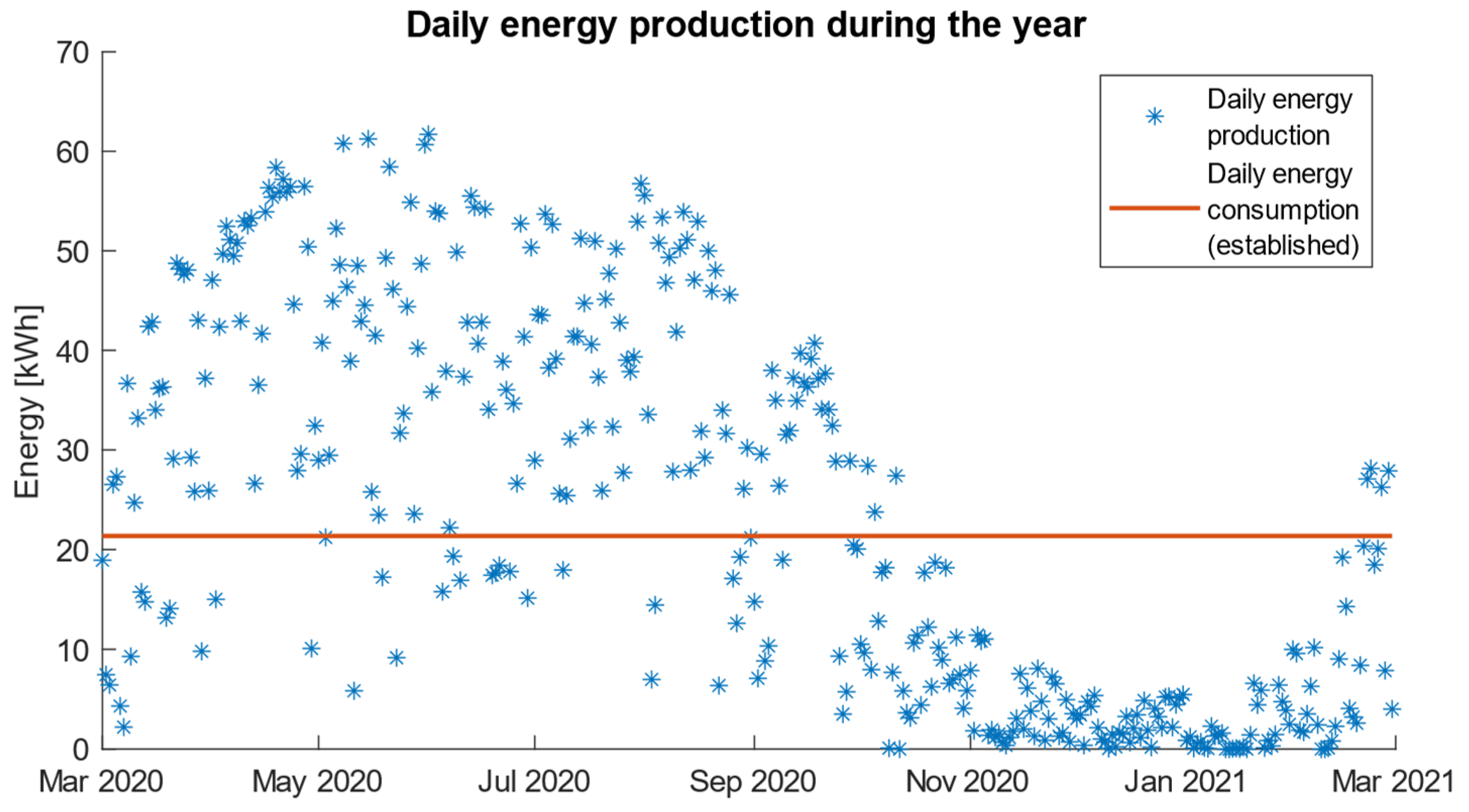
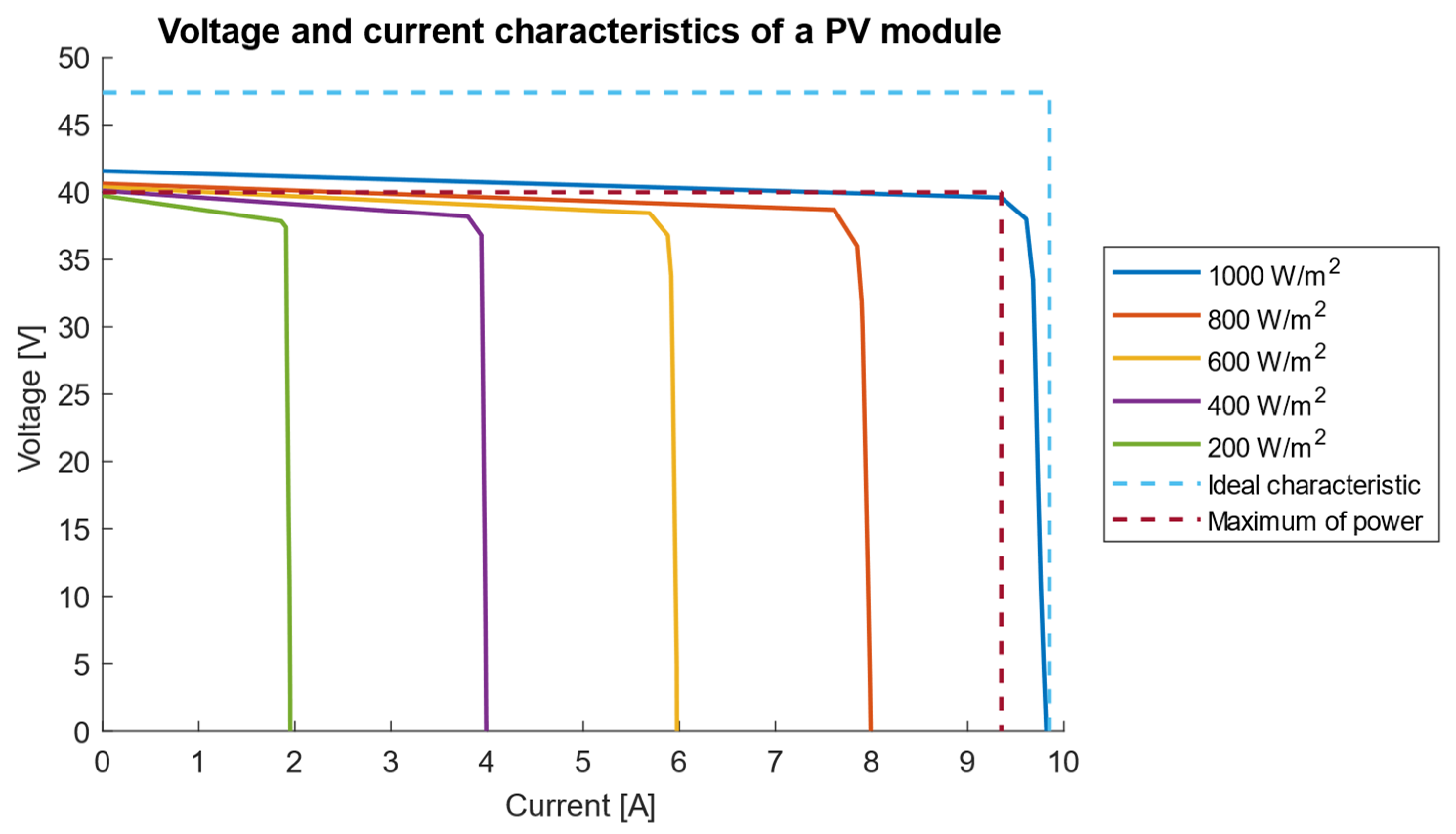

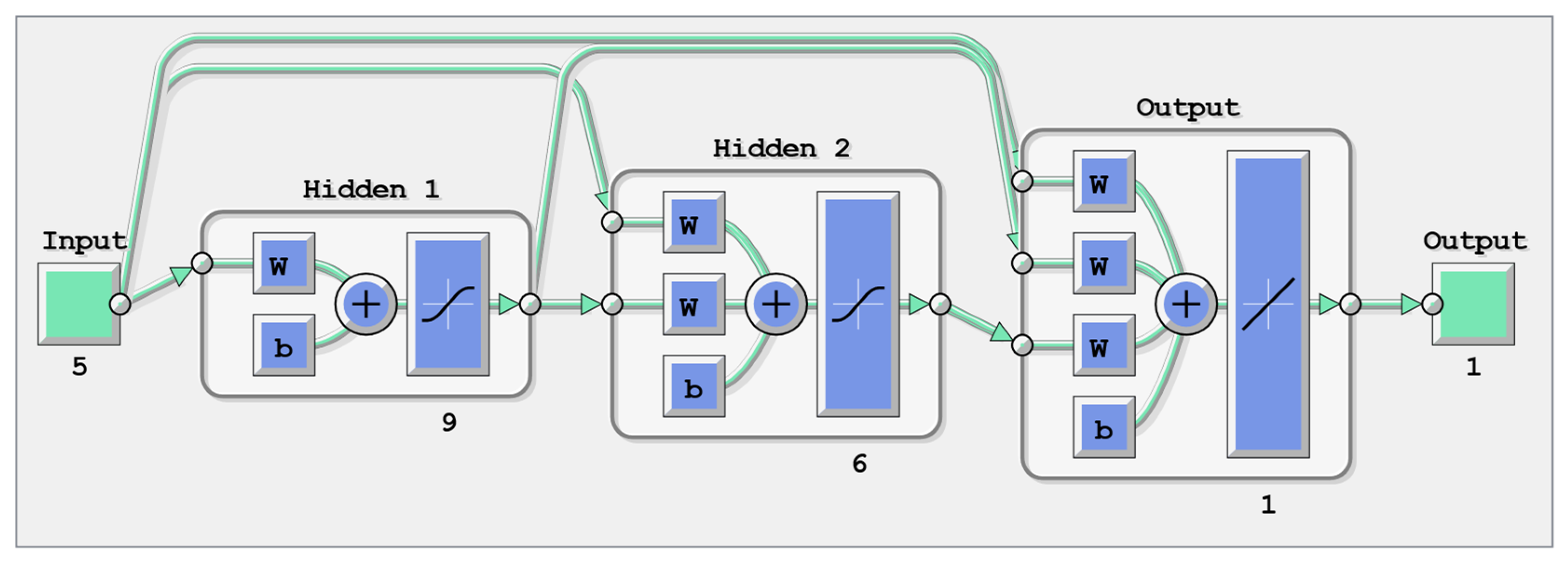
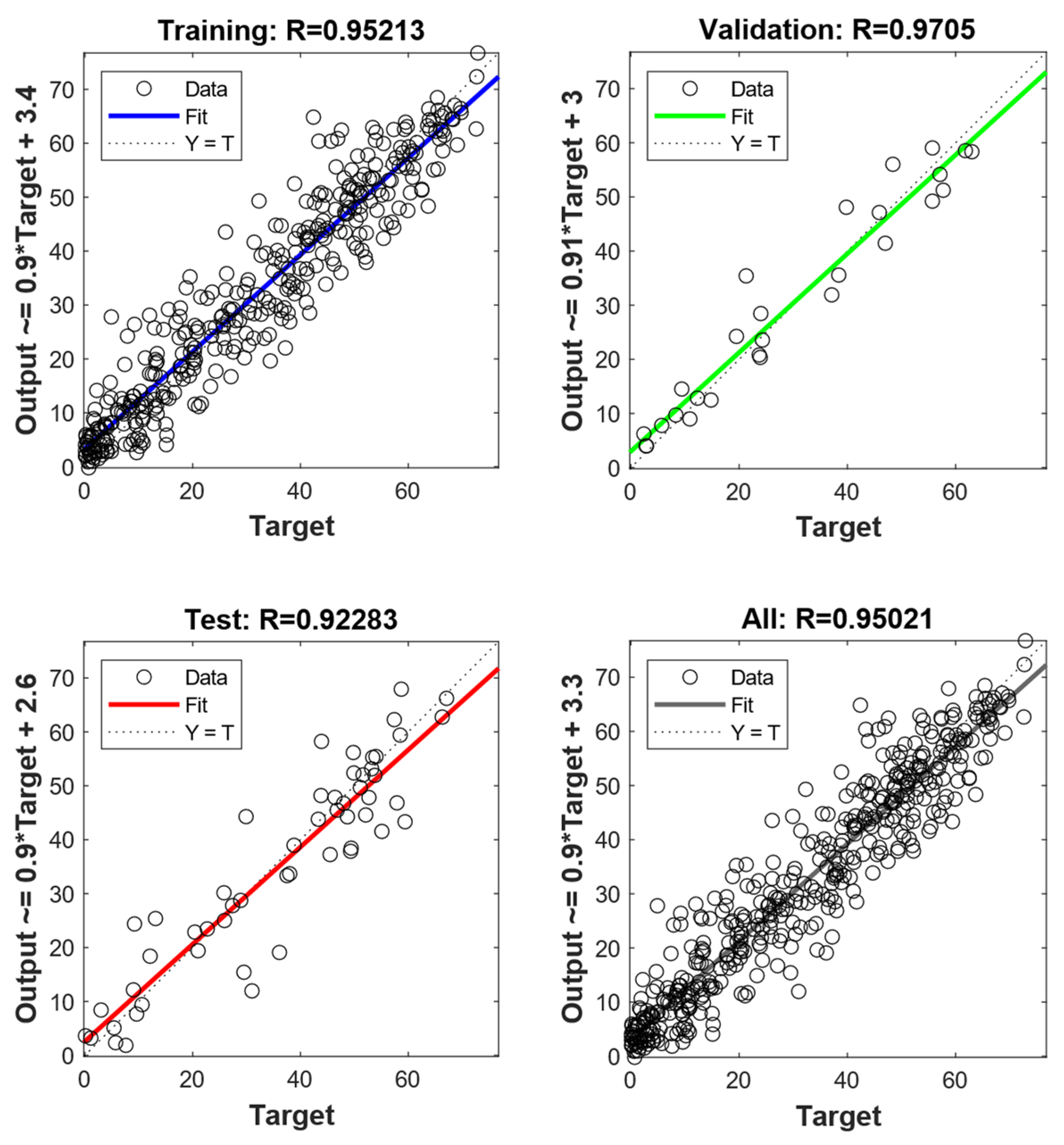

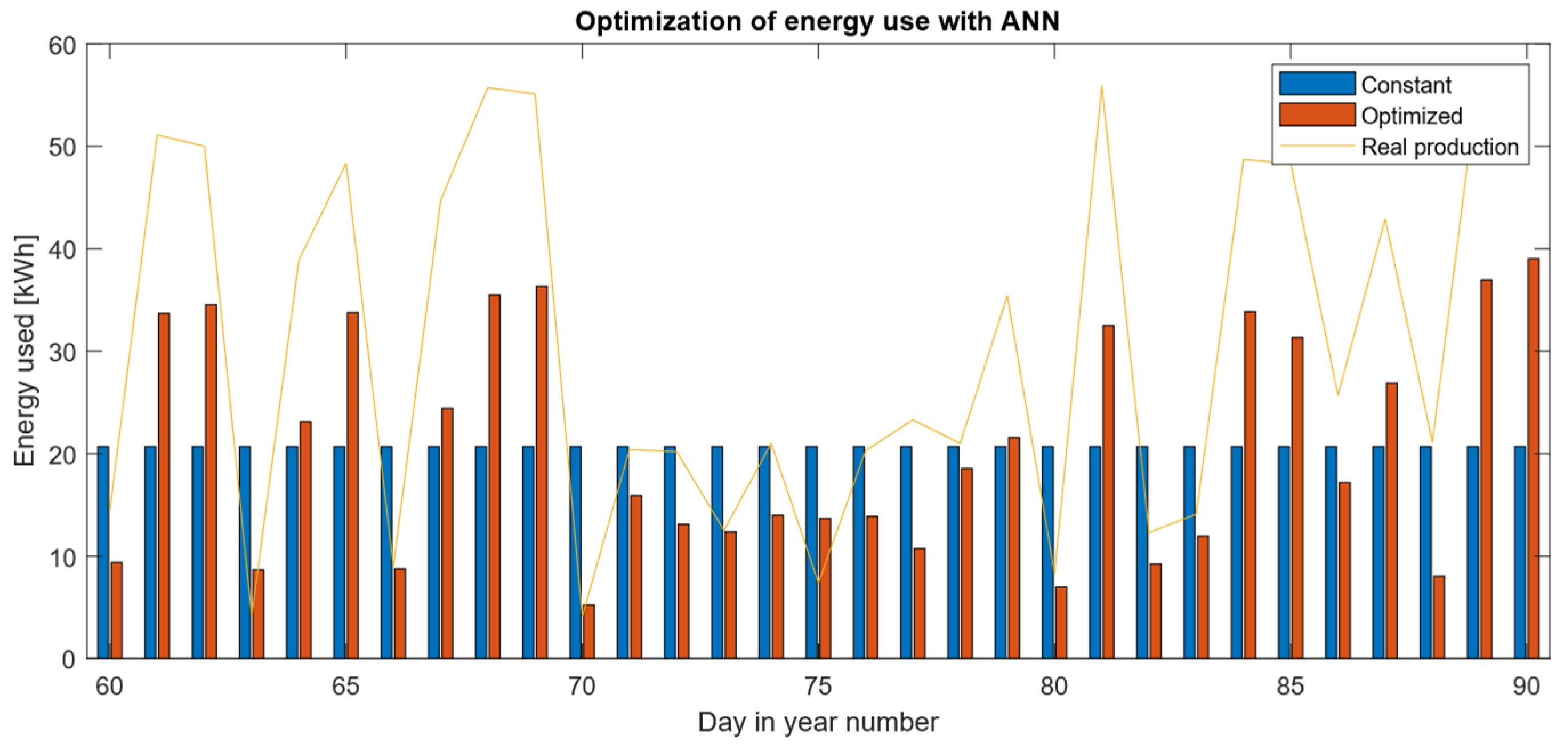
| Month | March | May | December | Annual (Approximated) | |
|---|---|---|---|---|---|
| Energy coverage (%) | Optimized | 98.13 | 98.90 | 36.85 | 996.03 |
| Unoptimized | 84.25 | 94.41 | 36.74 | 898.95 | |
| Installation gain (€) | Optimized | 31.73 | 67.08 | −52.18 | 235.08 |
| Unoptimized | 29.42 | 66.34 | −52.20 | 218.94 | |
| Emission reduction (kgCO2) | Optimized | 452.26 | 455.81 | 169.83 | 4590.49 |
| Unoptimized | 388.29 | 435.12 | 169.33 | 4143.07 |
Disclaimer/Publisher’s Note: The statements, opinions and data contained in all publications are solely those of the individual author(s) and contributor(s) and not of MDPI and/or the editor(s). MDPI and/or the editor(s) disclaim responsibility for any injury to people or property resulting from any ideas, methods, instructions or products referred to in the content. |
© 2024 by the authors. Licensee MDPI, Basel, Switzerland. This article is an open access article distributed under the terms and conditions of the Creative Commons Attribution (CC BY) license (https://creativecommons.org/licenses/by/4.0/).
Share and Cite
Postawa, K.; Czarnecki, M.; Wrzesińska-Jędrusiak, E.; Łyskawiński, W.; Kułażyński, M. Cascade-Forward, Multi-Parameter Artificial Neural Networks for Predicting the Energy Efficiency of Photovoltaic Modules in Temperate Climate. Appl. Sci. 2024, 14, 2764. https://doi.org/10.3390/app14072764
Postawa K, Czarnecki M, Wrzesińska-Jędrusiak E, Łyskawiński W, Kułażyński M. Cascade-Forward, Multi-Parameter Artificial Neural Networks for Predicting the Energy Efficiency of Photovoltaic Modules in Temperate Climate. Applied Sciences. 2024; 14(7):2764. https://doi.org/10.3390/app14072764
Chicago/Turabian StylePostawa, Karol, Michał Czarnecki, Edyta Wrzesińska-Jędrusiak, Wieslaw Łyskawiński, and Marek Kułażyński. 2024. "Cascade-Forward, Multi-Parameter Artificial Neural Networks for Predicting the Energy Efficiency of Photovoltaic Modules in Temperate Climate" Applied Sciences 14, no. 7: 2764. https://doi.org/10.3390/app14072764
APA StylePostawa, K., Czarnecki, M., Wrzesińska-Jędrusiak, E., Łyskawiński, W., & Kułażyński, M. (2024). Cascade-Forward, Multi-Parameter Artificial Neural Networks for Predicting the Energy Efficiency of Photovoltaic Modules in Temperate Climate. Applied Sciences, 14(7), 2764. https://doi.org/10.3390/app14072764







